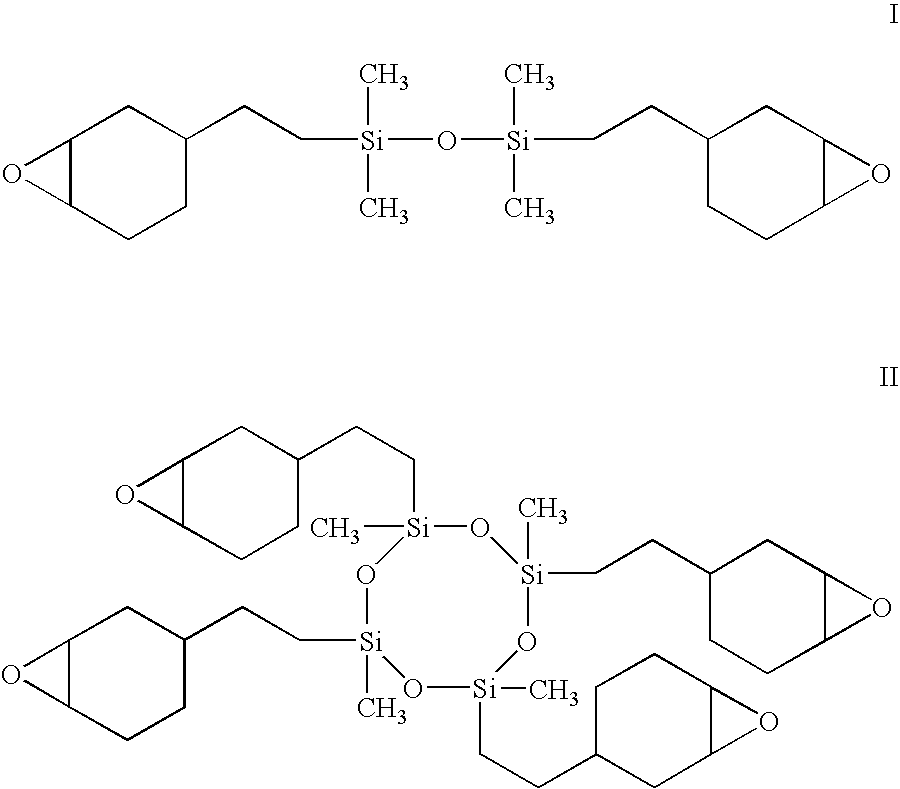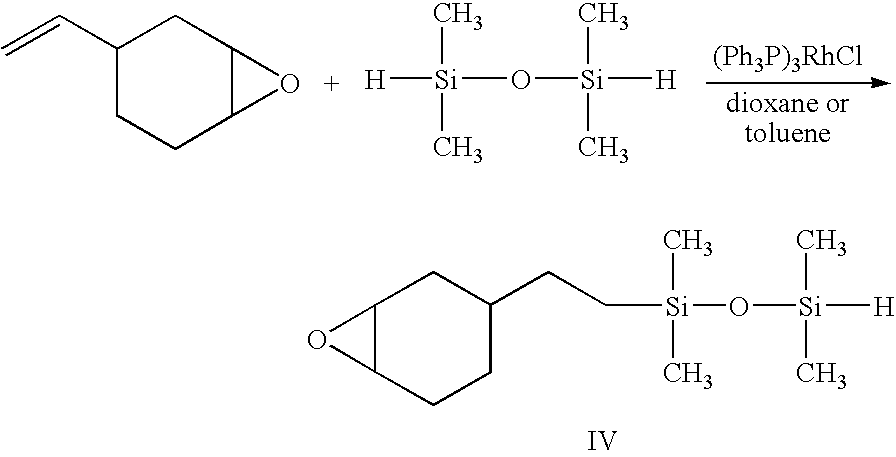Siloxane monomers and oligomers
a technology applied in the field of oligomers and monomers, can solve the problems of not having the purity required for epoxides, not optimally designed monomers, and producing glass-like materials with little elongation and flexibility, and achieve high purity
- Summary
- Abstract
- Description
- Claims
- Application Information
AI Technical Summary
Benefits of technology
Problems solved by technology
Method used
Image
Examples
example 1
Synthesis of (1,7-Bis(1,2-epoxycyclohexyl-4-ethyl))-1,1,3,3,5,5,7,7-octamethyl-tetrasiloxane (V) by Hydrosilation
[0043] To a 100 mL round-bottom flask fitted with a magnetic stirrer and a reflux condenser were added 8.48 g (0.03 mol) of 1,1,3,3,5,5,7,7-octamethytetrasiloxane, 8.70 g (0.075 mol) of 3-vinyl-7-oxabicyclo[4.1.0]heptane, 40 mL of freshly distilled dry toluene. There were added 11 mg of polymer-bound Wilkinson's catalyst and the reaction mixture heated at 100-115° C. for 48 h by means of an oil bath. The course of the reaction was monitored using infrared spectroscopy by following the disappearance of the Si—H band at 2125 cm−1. When the infrared band had completely disappeared, the reaction was terminated and the reaction mixture filtered to remove the catalyst. The unreacted starting materials and solvent were removed under reduced pressure and high vacuum. After purification by flash chromatography over silica gel using chloroform as an eluent, there were obtained 15....
example 2
Synthesis of (1,7-Bis(1,2-epoxycyclohexyl-4-ethyl))-1,1,3,3,5,5,7,7-octamethyl-tetrasiloxane (V) by Dehydrodimerization
[0045] Into a 100 mL round-bottom flask fitted with a magnetic stirrer and a reflux condenser were added 6.72 g (0.05 mol) of 1,1,3,3-tetramethyldisiloxane (TMDS), 6.83 g (0.055 mol) of 3-vinyl-7-oxabicyclo[4.1.0]heptane, 15 mL of freshly distilled toluene or 1,4-dioxane and approximately 7 mg of polymer-bound Wilkinson's catalyst. The reaction mixture was heated at 65-70° C. for 10 h. The progress of the reaction was followed by 1H NMR in CDCl3 by monitoring the reduction in the intensity of the Si—H band (4.67 ppm) due to the starting material, TMDS and the loss of the olefinic protons (4.93 and 5.7 ppm) of the vinyl epoxide. After 5 h reaction, 99% of the starting epoxide was consumed (step 1).
[0046] After cooling to room temperature, there were added 3-4 drops of triethylamine as an inhibitor and the reaction vessel fitted with an air inlet and a water trap. T...
example 3
Synthesis of Epoxy-Silicone Oligomers
[0047] The following procedure employed for the synthesis of the epoxy-functional oligomer XIIc is typical for the synthesis of all the oligomers prepared during the course of this investigation.
First Step: Hydrosilation
[0048] Into a 100 mL round-bottom flask fitted with a magnetic stirrer and a reflux condenser were placed 8.22 g (0.025 mol) of tetrakis(dimethylsiloxyl)silane, 6.21 g (0.050 mol) of 3-vinyl-7-oxabicyclo[4.1.0]heptane, 10 mL of freshly distilled toluene (or 1,4-dioxane) and approximately 7-8 mg of polymer-bound Wilkinson's catalyst. The reaction mixture was heated at 65-70° C. for 18 h. The progress of the hydrosilation reaction was followed by 1H NMR in CDCl3 by monitoring the disappearance of the vinyl groups of VCHO and also by following the appearance of the product. After 12 h reaction, 99% of the starting epoxide was consumed.
Second Step: Dehydrocoupling
[0049] After cooling to room temperature, there were added 5-7 dr...
PUM
| Property | Measurement | Unit |
|---|---|---|
| temperature | aaaaa | aaaaa |
| time | aaaaa | aaaaa |
| incident angle | aaaaa | aaaaa |
Abstract
Description
Claims
Application Information
 Login to View More
Login to View More - R&D
- Intellectual Property
- Life Sciences
- Materials
- Tech Scout
- Unparalleled Data Quality
- Higher Quality Content
- 60% Fewer Hallucinations
Browse by: Latest US Patents, China's latest patents, Technical Efficacy Thesaurus, Application Domain, Technology Topic, Popular Technical Reports.
© 2025 PatSnap. All rights reserved.Legal|Privacy policy|Modern Slavery Act Transparency Statement|Sitemap|About US| Contact US: help@patsnap.com



